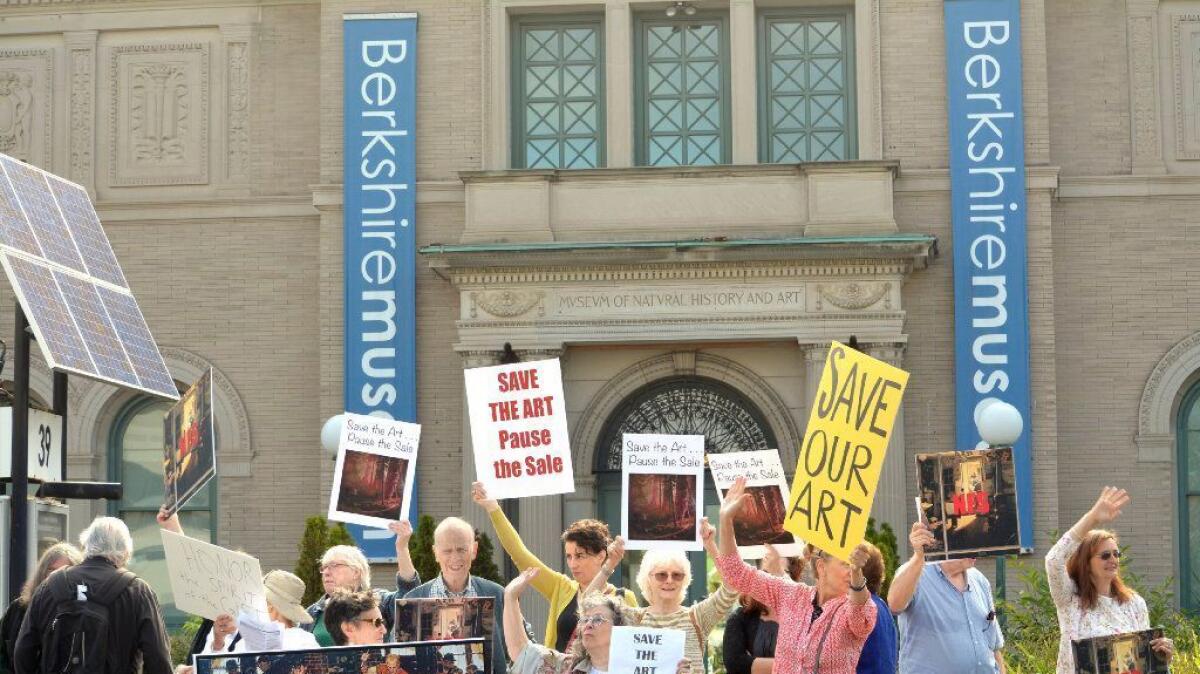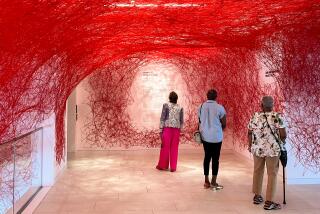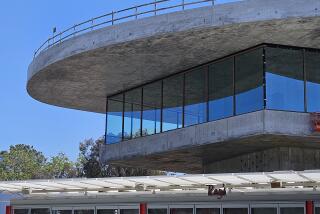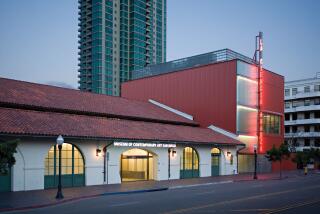Perspective: Why a Massachusetts museum selling its prized Norman Rockwell painting should worry art museums everywhere

- Share via
Maybe it’s the record-breaking summer temperatures, exacerbated by global warming, but some art museum folks in the Berkshire Hills of western Massachusetts seem to be suffering from heatstroke. Plainly they’ve lost their minds.
In late July, the Berkshire Eagle, Pittsfield’s local newspaper, reported that the Berkshire Museum, the town’s long-struggling museum of history, science and art, finished off a two-year self-examination by deciding to sell off 40 of the most notable paintings, sculptures and drawings from a collection not known to be overstuffed with outstanding art.
The reason for the sale: to raise as much as $60 million to fund future museum operations. If this is the museum’s solution to its fiscal woes, I’d say it’s time to fold its tent and close.
This is the second, much larger de-accession of the museum’s art in the last decade. (At the time of a 2008 building renovation, an auction of three paintings netted more than $8 million.) The plan is unethical.
Norman Rockwell, for one, is unlikely to have donated one of his finest paintings so that it could be sold off some day to pay the Berkshire Museum light bill. The marquee work for disposal is his 1950 “Shuffleton’s Barbershop,” an after-hours glimpse through a small-town shop window.
The marquee work for disposal is [Norman Rockwell’s] 1950 ‘Shuffleton’s Barbershop,’ an after-hours glimpse through a small-town shop window.
Out past the neatly ordered magazine rack, beyond the darkened barber chair and glowing pot-bellied stove churning out nighttime warmth, a group of three silver-haired men is gathered in a brightly lighted backroom. The day’s work is done; with violin, cello and clarinet in hand, music is being made.
Homey views from a darkened foreground room into a lighted space at the rear were a specialty of 17th century Dutch artist Pieter de Hooch — whose painting “The Music Party” is also being dumped. So are fine examples by Alexander Calder, Albert Bierstadt, Frederic Edwin Church, George Inness, Rembrandt Peale and two dozen others.
Rockwell’s family wrote a letter to the paper objecting to the sale. Other observers, once they lifted their dropped jaws off the floor, also went ballistic.
In an unusual joint declaration, both the American Alliance of Museums and the Assn. of Art Museum Directors, the two most prominent professional groups in the field, condemned the plan.
“One of the most fundamental and long-standing principles of the museum field is that a collection is held in the public trust and must not be treated as a disposable financial asset,” the statement says (italics theirs), reciting a self-evident truth. That’s the reason that the appraised value of an art collection is typically not carried on a museum’s balance sheet, nor reported along with cash assets in IRS filings.
“Such a sale sends a message to existing and prospective donors that museums can raise funds by selling parts of their collection,” they continue, “thereby discouraging not only financial supporters, who may feel that their support isn’t needed, but also donors of artworks and artifacts, who may fear that their cherished objects could be sold at any time to the highest bidder to make up for a museum’s budget shortfalls.”
I can hear a trustee in California or New York now: “But why can’t we sell the museum’s jewels to fund my pet project? That Massachusetts museum did!” Between board and staff, unnecessary and injurious scuffling ensues.
So much for collegiality. In trashing its own prospects, the Berkshire Museum jeopardizes every art museum in the United States.
The 1,300-member Assn. of Art Museum Curators presently made the professional censure a trifecta, issuing its own disapproving statement about the bald-face violation of best museum practices. No sooner had the digital ink dried on it than a shocking opinion piece appeared in the Eagle.
The director of an art museum in North Adams, 45 minutes up the road from Pittsfield, penned a bizarre, full-throated defense of the obscene sale.
“Deaccessioning is the most serious business for museums, and deserves the utmost diligence,” wrote Joseph Thompson, director at the Massachusetts Museum of Contemporary Art — an institution, it must be pointed out, that can’t itself de-accession because it has no art collection of its own. “Done correctly — at the right scale, at the right time, for the right reason — it can also invigorate and even save institutions.”
What scale, time and reason are right in Thompson’s view? Just enough to cover the costs of changing the museum’s mission, it turns out.
In the face of dwindling community resources in the last several decades, as Pittsfield’s population declined by 25% and corporate heavy-hitters like General Electric, a major patron, left town, the Berkshire Museum has encountered serious structural deficits. According to the Eagle, the museum with a tiny $2.4 million budget has averaged a $1.15 million shortfall annually for more than 10 years.
So a plan has been devised to refocus institutional emphasis onto interactive, multimedia science and history programs. The hope is that becoming a gizmo museum will boost interest, attendance and income.
Fine by me if the museum wants a mission change. (I grew up about an hour down Route 20 from Pittsfield and was never much enamored of the place.) But the issue is how it’s done.
Thompson advised the Berkshire Museum on the overhaul. Arguing the virtues of venality, he wrote that without another feasible path to a sustainable financial reboot, liquidating its most valuable art is necessary.
Thompson’s own nearby museum must fish in the region’s same shallow funding pool, of course, so urging the Berkshire Museum to raise money by selling its collection handily knocks out a competitor. Downgrading art programs in favor of science and history, he implies, means you can rob Peter to pay Paul and Paulette.
Except, it doesn’t.
Why not? Because the museum — not the trustees, not the staff — doesn’t own the Rockwell except in the most banal sense. The public does.
The public owns the painting, along with all the rest scheduled to go on the block, starting in November. Trustees and staff are stewards of the art collection, charged with taking whatever measures are best for it.
Yet this museum’s leaders are behaving as if they are stewards of the institution, not the art. Absurdly, museum standards are being vandalized to protect the museum.
“We can’t care for our collection if we don’t exist,” Berkshire Museum director Van Shields told the New York Times. “The fact is, we’re facing an existential threat.”
Board president Elizabeth McGraw concurred in an impassioned public letter posted on the museum’s website, warning, “[If] we do not transform the museum into a sustainable, thriving institution, it will eventually close.”
[If] we do not transform the museum into a sustainable, thriving institution, it will eventually close.
— Elizabeth McGraw, Berkshire Museum board president
Here’s an idea: Don’t sell the art. Do close the museum.
Start behaving like the charitable institution you are supposed to be. Spend the next several years responsibly overseeing the dispersal of the collection.
Donate the art to other museums that would benefit most from having it. (The art collection numbers just over 5,000 objects from the 15th to the 20th centuries, plus ancient artifacts.) Because the state gives the Berkshire Museum a subsidy through tax breaks, in addition to its federal one, Massachusetts has a priority stake; so its many other museums should get the first (but not the only) consideration for gifts.
Shields has said that, without the sale, the institution can’t survive beyond the next eight years. That affords plenty of time to unwind the Berkshire Museum, an honorable task at least as hard as conceiving a last-ditch overhaul with no guarantee of success.
Drastic, I know. And a sad loss for Pittsfield. It would be a psychic blow to a city that still struggles economically.
But the hard truth is that if its community cannot sustain the museum, not much can be done. (“If wishes were horses,” and all.) Surely the answer is not to rip the art away from the public to send it off to market, where almost certainly it will disappear into private hands.
“Shuffleton’s Barbershop” alone is worth a fortune — the auction record for a Rockwell is $46 million — and barely any American museum can afford to buy it. You can bet that Sotheby’s, the auction house handling the sale, will be sending the masterpiece to Los Angeles for display to heighten the interest of billionaire Hollywood directors Steven Spielberg and George Lucas, the two top private collectors of Rockwell’s art.
To save itself, the Berkshire Museum is not just monetizing its art collection. The art is also being privatized. That’s the ultimate betrayal of public charitable status. With community treasures being turned into private possessions, the public is the loser.

Twitter: @KnightLAT
MORE ART NEWS AND VIEWS:
Answers to the question: What should we do with Confederate monuments?
Grand Avenue is getting color: Artist Carlos Cruz-Diez’s street installation at the Broad
With just carved wood or terra cotta, one artist makes the miniature feel monumental
More to Read
The biggest entertainment stories
Get our big stories about Hollywood, film, television, music, arts, culture and more right in your inbox as soon as they publish.
You may occasionally receive promotional content from the Los Angeles Times.











